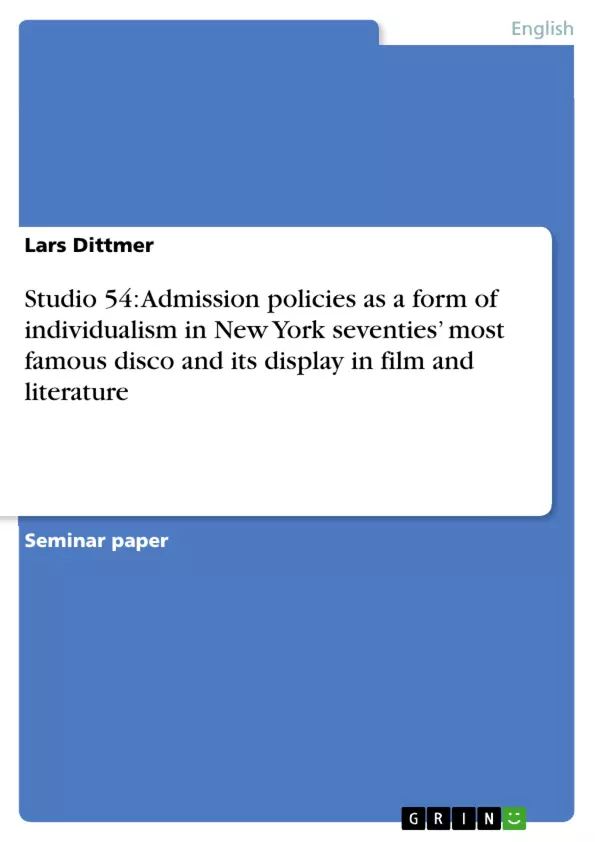„...and for three years it was the most talked-about, written-about and shocked-about venue in the universe. Everyone wanted to go to Studio 54 (Jones/ Kantonen 1999: 246)”.
“A lot of people thought that at the door was a better show than inside...people would try anything to get in (“Shane” in Studio 54)”.
When Steve Rubell and Ian Schrager in the late April 1976 started their nightclub Studio 54, a legend came to life. On the floors of this unique party shangri-la, celebrities like Andy Warhol, Liza Minelli, Bianca and Mick Jagger, Brooke Shields and Truman Capote mingled with business people, politicians, soap opera starlets, drag queens and chosen few from the “grey people”, as nightlife guru Rubell called the normal people. Never before, a discothèque had caused such a public stir. Paparazzi jostled beyond the velvet ropes to illustrate their gossip columns with pictures of the socialites – it was the “first time ever that celebrity photos would appear on the front page of the tabloids for no other reasons than they were there (Jones/ Kantonen 1999: 249)”.
But by far not everybody came to know the true promise of the club – door policy at Studio 54 was probably one of the toughest in the history of nightlife. Rubell himself was eager to make sure that of the many different groups that made up the audience of 54, none should dominate the other, a type of “social engineering he called “tossing the salad”” (Shapiro 2005: 201). He himself supported his doorman Marc Benecke selecting the people who could pass the velvet ropes, whilst scores of people shouted Rubell’s name begging him to be admitted into the club. On one hand, there were certain criteria, but on the other hand, there was enough leeway for arbitrariness, indeed, it was a highly undemocratic procedure that precisely reflected its place, its period and social circumstances.
Disco in the 'uncanny 1970s' not only served to escape reality but also epitomised an increasing drive towards individualism that replaced the ideas of participation and community of the sixties. The doors at 54 were instruments to form a new world with new social ladders and in their radicalism marked a peak in this development.
Inhaltsverzeichnis (Table of Contents)
- General Introduction
- Introduction and problem identification
- Approach of this term paper
- The Seventies – need to escape?
- The faceless decade
- The economic downturn - stagflation and unemployment
- Repercussions of Vietnam
- Disco feared and sneered at
- Countercultural phenomenon or foofaraw?
- Home of the Disenfranchised
- Studio 54 - Queen of Manhattan
- Steve Rubell, Ian Schrager and their dream
- Drug supply at 54
- Escaping the “grey people”: door policy at Studio 54
- The “right mix”
- Tossing the salad
- The inner-sanctum
- Conclusion
Zielsetzung und Themenschwerpunkte (Objectives and Key Themes)
This term paper explores the new hierarchies established at Studio 54 in the late 1970s, focusing on the cultural and historical context that shaped this phenomenon. It examines disco as a trend towards escapism, hedonism, and individualism, with Studio 54 representing its most extreme manifestation. The paper also explores the United States in the 1970s, which exhibited attributes of a deteriorating industrialized country, with New York City serving as a focal point.
- The emergence of disco as a cultural phenomenon in the 1970s.
- The role of Studio 54 as a symbol of escapism and hedonism.
- The impact of the 1970s socio-economic climate on American society.
- The evolution of individualism and its manifestation in the nightclub scene.
- The selective door policy at Studio 54 as a form of social engineering.
Zusammenfassung der Kapitel (Chapter Summaries)
The initial chapter introduces the concept of Studio 54 as a symbol of hedonism and escape, highlighting the club's impact on the cultural landscape of the 1970s. It provides a brief overview of the historical context, setting the stage for the subsequent chapters. The second chapter explores the 1970s in the United States as a decade of social and economic upheaval, examining the factors that led to the rise of disco as a means of escapism. The third chapter delves into the phenomenon of disco, emphasizing its association with individualism and hedonism. It introduces Studio 54 and its founders, Rubell and Schrager, outlining the reasons for its unique status in the nightclub scene.
Schlüsselwörter (Keywords)
The term paper examines the cultural and historical context of Studio 54 as a nightclub that epitomized escapism, hedonism, and individualism in the late 1970s. It delves into the social and economic climate of the 1970s in the United States, particularly in New York City, and explores the relationship between disco and the rise of individualism. The paper focuses on the selective door policy at Studio 54 as a form of social engineering, reflecting the changing social dynamics of the era.
- Arbeit zitieren
- Lars Dittmer (Autor:in), 2006, Studio 54: Admission policies as a form of individualism in New York seventies’ most famous disco and its display in film and literature, München, GRIN Verlag, https://www.grin.com/document/51589



